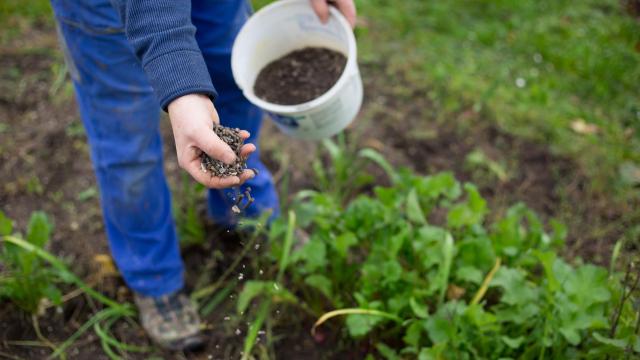Autumn is one of the three times of year you fertilize. When plants are ready to wake up in spring, you surprise them with a brunch of nitrogen-rich plant food to help them grow; in summer, you give them boosts of phosphorus and potassium to give them a brain food they need to make vegetables, flowers, and fruit. And in fall, you’re really giving plants a midnight snack before they head off to sleep. Like bear in hibernation, they need to put on a little weight to make it through a long winter.
To be clear, the best fertilizer is a cover crop in the off season, and there are all sorts of them that feed nutrients back into the soil while also improving the actual condition of the soil, like oil-driller radish, which will break up hard soil. Consistently testing your soil and adding compost—whether that’s from kitchen scraps, leaf mold, or just the stuff you pick up at the garden center—will also keep your soil healthy. But make no mistake, there are plants in your yard that could use a fertilizer snack made for their special needs.
How to choose the best autumn fertilizers
As you look at fertilizers, it’s sometimes helpful to know that the numbers on the front always represent nitrogen-phosphorus-potassium, in that order. Nitrogen boosts foliage growth, as mentioned above, while phosphorus encourages root growth. Potassium promotes flower and fruit growth, but serves a very second important purpose: It is necessary for your plants to get uptake of trace minerals like calcium (and if you’ve ever had tomato blossom rot, you know the importance of it).
For grass:
If the summer was hotter than usual or you cut off your lawn water at some point, letting it go dry, the rain will be a relief. But those blades need some food for healthy growth, so a 20-8-8 is recommended to give it that boost. The included phosphorus will help grass roots develop to get it through winter.
For perennials:
A 0-20-0, sometimes called “super phosphate,” can be sprinkled around your wilting perennials; this will help give them some extra root strength for the winter, since they likely have spent what they’ve got producing flowers and seed heads. They’ll come back bigger and better next year.
For fruit vines and trees:
All your fruit vines and trees need a fall boost, and if you’ve been experiencing “blah” harvests, this can be a game-changer for you. Look specifically for fruit vine and tree fertilizer, which will be heavy in nitrogen, like a 12-4-8. Apply it per the instructions, water it in a little, and then get those shrubs, vines, and trees mulched in for the cold season.
For trees and shrubbery:
Not matter how well-established, trees and shrubs need a snack; sometimes I forget my really big trees do still need me. When really grown-out, shrubs and trees don’t react suddenly to draught or lack of food, so it’s hard to notice, but it’s important to keep the food (and water) train going. For these plants, look for slow-release nitrogen fertilizer for fall, and remember, you’re not just fertilizing the few feet around a tree, but everywhere the roots might be, so spread out.
Bulbs:
Bulbs are a long game, but whether you put them in this year or last, you’ll want that super phosphate fertilizer goodness spread around so those bulbs form sturdy roots so they can put up strong stems come spring.
Plants that need a little something else:
There are a few plants in your yard—azaleas, rhododendrons, and blueberries—that require more acidic fertilizer to really be their best selves. This is a specific fertilizer you can buy, and you should also consider it for hydrangeas, which colour-shift depending on the acidity of soil, and gardenias, camellias, and all your other fussy tree flowers. For areas that became really nitrogen-robbed during the summer, like where you planted corn, you’ll want to treat it with blood meal. It doesn’t smell great, but it does fix your soil.
If this sounds complicated, remember these are all just combinations of N-P-K—nitrogen (N), phosphorus (P), and potassium (K)—and you can play around with those components, and ask your local garden center for help, too.

Leave a Reply
You must be logged in to post a comment.